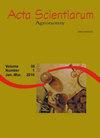Inoculation with Rhizobium tropici can totally replace N-fertilization in the recently released BRSMG Uai bean cultivar
IF 1.2
4区 农林科学
Q3 AGRONOMY
引用次数: 0
Abstract
The BRSMG Uai common bean cultivar (Phaseolus vulgaris L.) unites traits required by producers, such as high yield and upright stands, the latter of which is considerably improved in relation to previously released cultivars such as BRSMG Madrepérola and Pérola. However, the potential of the cultivar to form symbiotic relationships with rhizobia to fix N2 has not yet been assessed. Here, field experiments were conducted to assess the efficiency of biological nitrogen fixation (BNF) in the cultivar, and to compare this to the efficiencies of other genetic materials widely grown throughout Brazil (BRSMG Madrepérola and Pérola). Experiments were conducted on two Oxisols in Minas Gerais State, Brazil (one during the dry season in the south, and the other during the winter season in the Alto-Paranaíba region), under a no-tillage system over maize stover. A randomized block experimental design was implemented in a 3 × 3 factorial arrangement with four replicates. Individual and combined Analysis of Variance were performed and the data were normalized. Homogeneity of the residual mean squares was observed. Significant effects of factors were identified by Scott-Knott tests and F tests. The BRSMG Uai cultivar responded to inoculation with the rhizobial strain CIAT 899, with yields similar to those achieved upon fertilization with 80 kg ha-1 of N-urea and to the yields of the BRSMG Madrepérola and Pérola cultivars inoculated with the same rhizobial strain. In terms of commercial use, this cultivar may be successful under either of the management practices adopted for N supply, and from the perspective of plant breeding, it has potential for inclusion in breeding programs directed toward improving BNF.在新发布的BRSMG淮豆品种中,接种热带根瘤菌可以完全替代氮肥
BRSMG Uai普通豆品种(Phaseolus vulgaris L.)结合了生产者所要求的性状,如高产和直立直立,后者与以前发布的BRSMG madrepsamola和psamola等品种相比有很大改善。然而,该品种与根瘤菌形成共生关系以固定N2的潜力尚未得到评估。在此,通过田间试验评估了该品种的生物固氮效率,并将其与巴西广泛种植的其他遗传物质(BRSMG madrepsamola和psamola)的效率进行了比较。在巴西米纳斯吉拉斯州的两个Oxisols(一个在南部的旱季,另一个在Alto-Paranaíba地区的冬季)进行了试验,采用玉米秸秆免耕系统。采用随机区组试验设计,采用3 × 3因子设计,共4个重复。进行个体和组合方差分析,并对数据进行归一化处理。观察残差均方的均匀性。通过Scott-Knott检验和F检验确定各因素的显著影响。BRSMG Uai品种对接种根瘤菌CIAT 899有响应,产量与施用80 kg hm -1 n -尿素时的产量相似,与接种同一根瘤菌的BRSMG madresamola和psamola品种的产量相似。就商业用途而言,该品种在两种氮素供应管理方法下都可能取得成功,从植物育种的角度来看,该品种有可能被纳入旨在改善BNF的育种计划。
本文章由计算机程序翻译,如有差异,请以英文原文为准。
求助全文
约1分钟内获得全文
求助全文
来源期刊

Acta Scientiarum. Agronomy.
Agricultural and Biological Sciences-Agronomy and Crop Science
CiteScore
2.40
自引率
0.00%
发文量
45
审稿时长
>12 weeks
期刊介绍:
The journal publishes original articles in all areas of Agronomy, including soil sciences, agricultural entomology, soil fertility and manuring, soil physics, physiology of cultivated plants, phytopathology, phyto-health, phytotechny, genesis, morphology and soil classification, management and conservation of soil, integrated management of plant pests, vegetal improvement, agricultural microbiology, agricultural parasitology, production and processing of seeds.
 求助内容:
求助内容: 应助结果提醒方式:
应助结果提醒方式:


